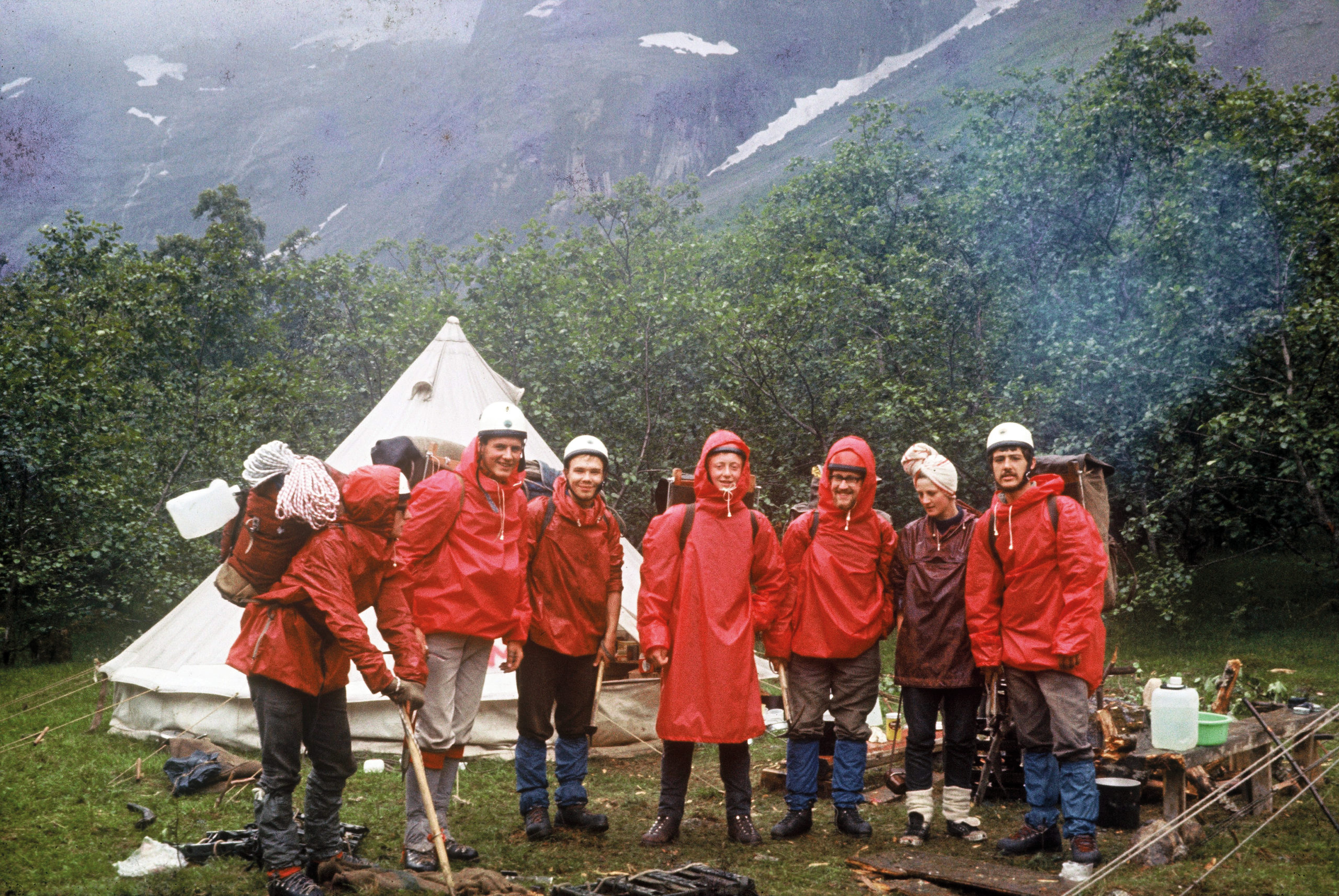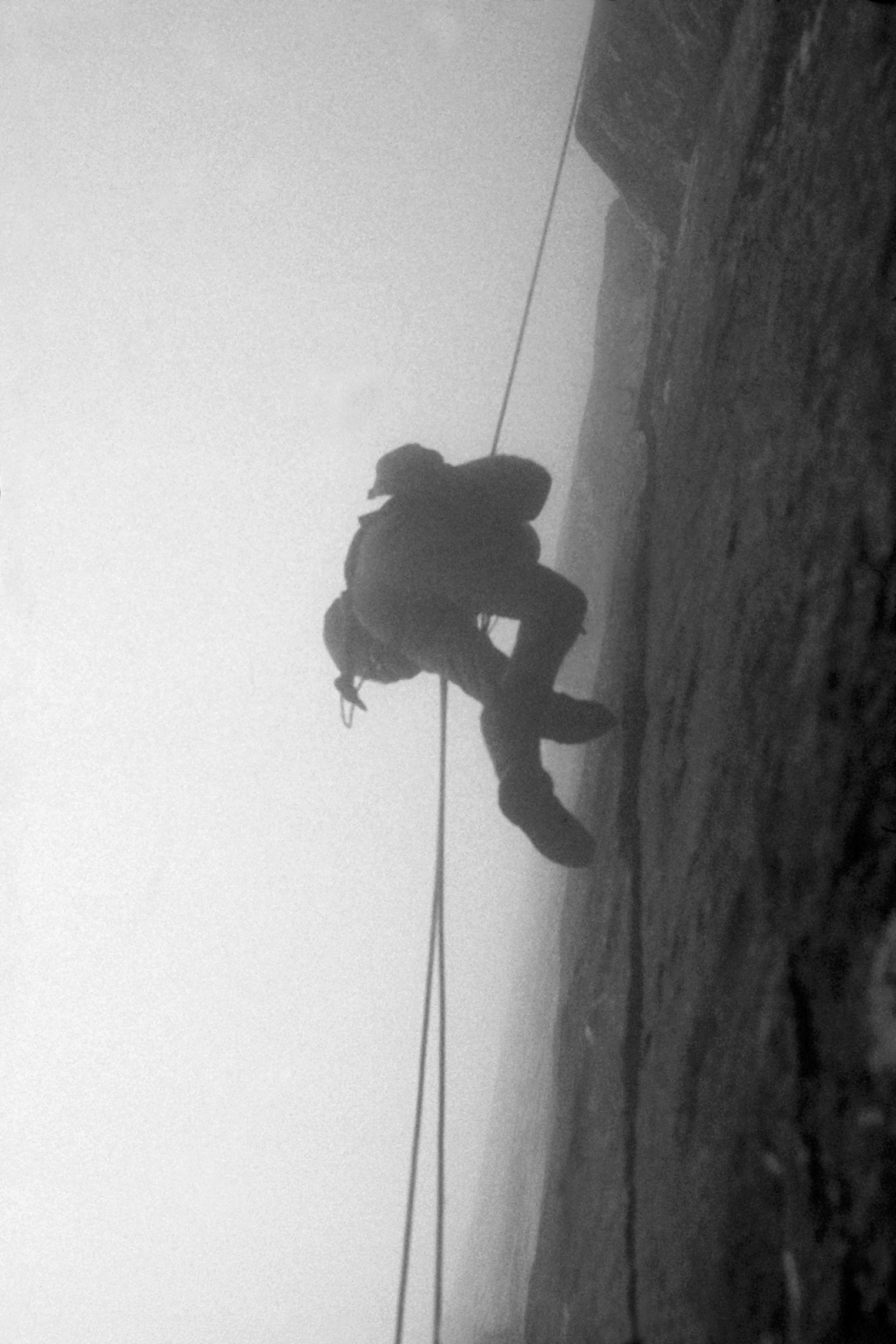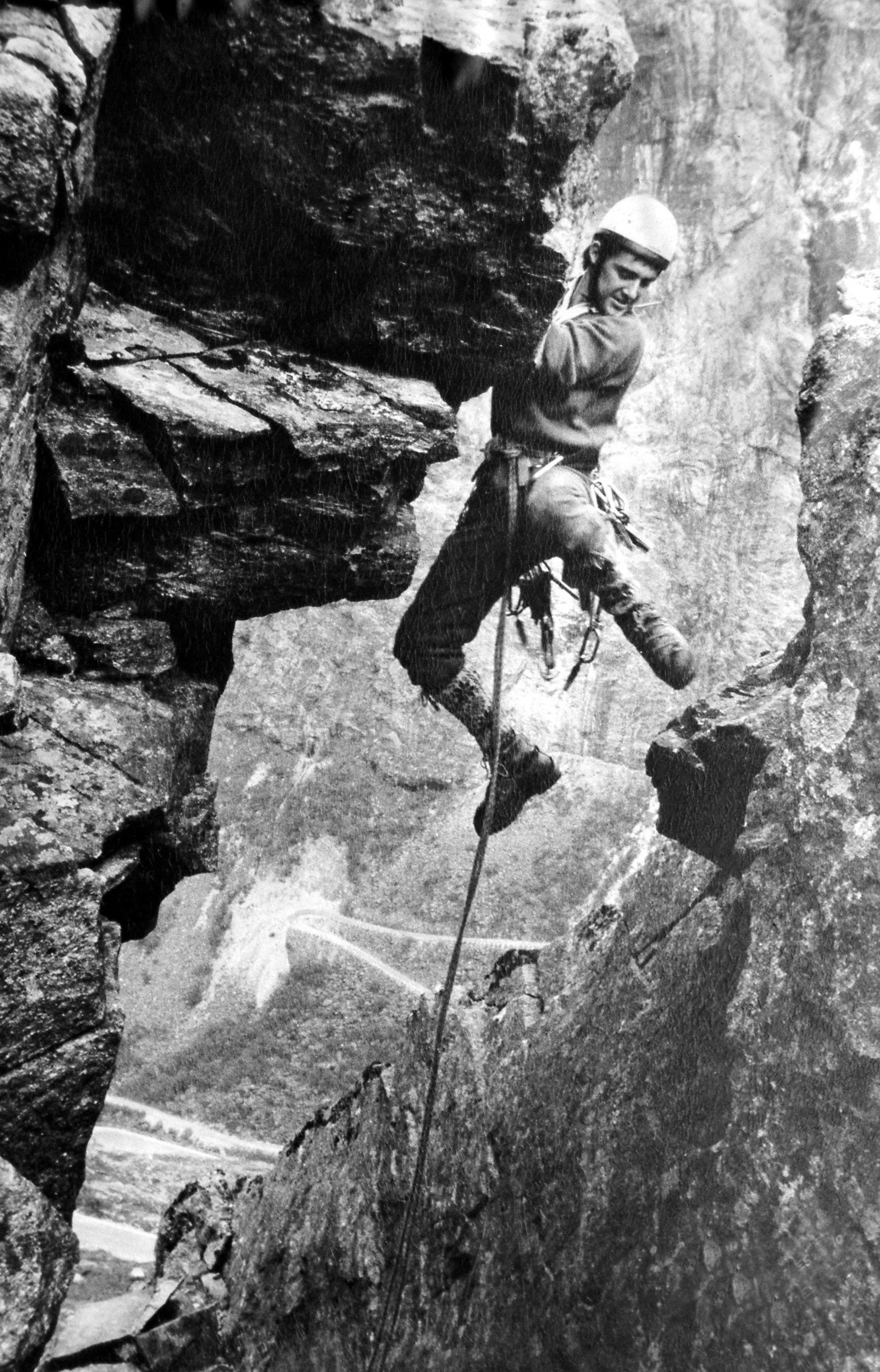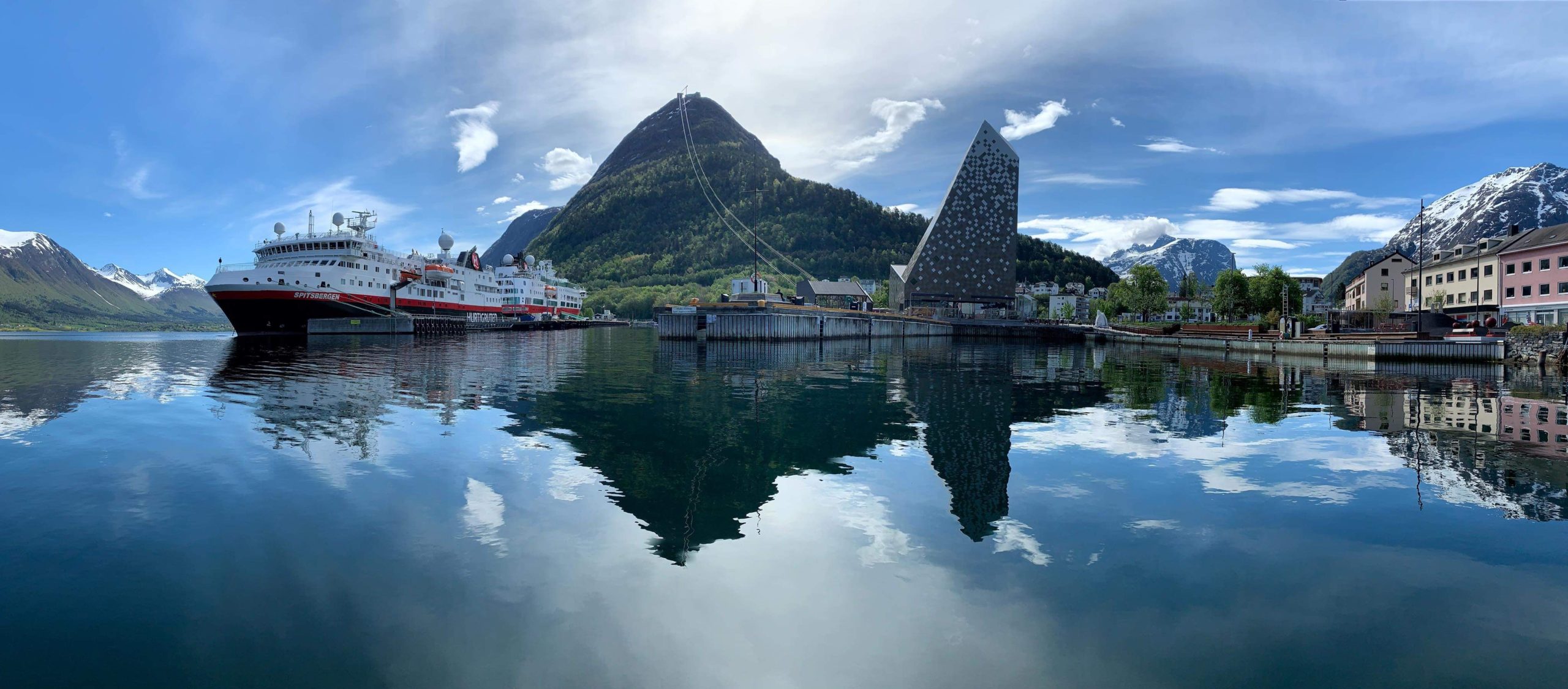If you were into new routes and big walls in the 1960s you would have known about a monster in Norway about which ominous stories circulated that can be summed up in one word: ‘unclimbable’.
The Troll Wall (Trollveggen) in Romsdal was also known as ‘the Vertical Mile’, and described as ‘the largest overhanging wall in Europe’. It was reputed to be smooth and holdless for 5,000 feet, and impossible without the aid of bolts. It also faces north and is as far north as Alaska’s Mt McKinley. Quite a proposition!
By Tony Howard – Member of The Rimmon Team from the Peak District in England which climbed the Troll Wall in 1965.
Visit Northwest
Visit Northwest is the official destination company for the Romsdalsfjord, Romsdal and Nordmøre area.
Troll Wall – The ‘unclimbable’ mountain
Strange then that none of the ‘big boys’ went for it. Instead a team from a small Peak District club called The Rimmon decided it was worth a go and in July 1965 despite everyone’s doubts and some horrendous weather they actually climbed it.

Apart from me, the rest of the team were Tony Nicholls (Nick), Bill Tweedale, John Amatt, Rob Holt, Jeff Heath and Margaret Woodcock. The six lads spent numerous days in bad weather on rain-soaked rock establishing a bivy at the foot of the face above the Introductory Slabs. The first attempt by Bill, Nick, John and me failed after five days, once again in atrocious weather, Nick getting us off the wall and trashing his hands in the process, which made it impossible for him to return. Bill, John and I returned a couple of days later and succeeded in five and a half days summiting just before another storm broke.
Following the ascent, one well known British climber who was very familiar with Norway actually wrote to JEB Wright, the editor of Mountaincraft implying that we must have found a way to sneak up the back without being noticed, but in the end the letter was never published. Conversely, Joe Brown said “The ascent must rank as one of the greatest ever achievements by British rock climbers”, and Aslak Aastorp, a top Norwegian climber, described the route as “a masterpiece of route finding at the highest free and aid standards of the day”. I think his grade comments were over enthusiastic, but I liked the route finding bit, as finding what proved to be the best natural line up the wall was something I was always pleased about.
“One of the greatest ever achievements by British rock climbers.” – Joe Brown
‘The competition’ – The Norwegians already had a rope fixed on the wall
Perhaps the most unusual thing about the ascent was that a team of Norwegian climbers arrived in Romsdal a day or two before us and by the time we arrived they already had a rope fixed on the wall. They had claimed their route. To our great relief it wasn’t on the route we had planned. To this day I’m not sure if it was a coincidence or they had been tipped off by Arne Randers Heen, Norway’s elder statesman of climbing with whom I had been corresponding.

The presence of two teams on the face was tailor made for a press hey-day. ‘The competition’ was in the news every day both in Norway and the UK. Though it never was a competition. The Norwegians, Leif Norman Pattersen, Odd Eliassen, Ole Daniel Enersen, Jon Teigland and girlfriends were camped not far from us. Leif Norman and Jon had both climbed in the Himalaya, whilst Ole Daniel and Odd were also amongst Norway’s top climbers.
Unlike us they were armed with an impressive collection of American hardware including Jumars and chrome-molly pegs which had been brought out from the States by Leif. It was all brand new on the market and totally unavailable in Europe. We, on the other hand, were stuck with Heibeler prusiks that were untrustworthy and our soft steel European pegs that crumpled at the first obstacle. Descenders were still to be invented as were sit harnesses. The Norwegians had chest harnesses. We had a waist belt of my design which could be made into a sit harness for abseiling and climbing roofs by the addition of a sit sling. It later became the Troll Mark 2 which led to the design of The Whillans Harness, then the Troll Mark 5 Harness designed by me, on which almost all modern climbing sit harness designs are now based. Our Troll Wall ascent was probably the last of the world’s big walls to be climbed in the old style with with ‘old gear’. No sit harnesses, no reliable ascenders, no descenders, no modern range of nuts, and bivy gear and waterproofs so bad we almost died.

But I digress. When we retreated on our first attempt, the Norwegians were in a better situation and survived the storm. As soon as the weather improved they continued with their route and topped out a day before us after eleven days on the face, much to the jubilation of the Norwegian press. Of course Bill, John and I were unaware until we came down after completing our route the following morning to be met by the press and members of both teams armed with copious amounts of celebratory beer before we were all feted in the Grand Hotel. It was reported in the Norwegian press that the Norwegian team ‘thought our achievement on the Troll Wall put theirs in the shade’, which was over-kind of them and far too modest.
The years after the climb – and the 50th anniversary in 2015
On the 50th anniversary of the climbs, both teams were invited to Romsdal for a celebratory reunion at the annual Mountain Festival in July. Arne Larsen wrote an article in the Norwegian magazine Klatring (Climbing) about the leader of the Norwegian team, Leif Norman Patterson. The story, which was later translated to English by Anders I. Ourom, says of Leif, he “was, by far, the most experienced of the four man team.

By 1965 he had nearly ten years’ experience on the hills, and was well known in the USA for his many challenging winter climbs. In addition he also brought much newly designed climbing equipment to Norway – hard steel pitons, several hundred metres of first-class ropes and slings, and Jumar rope-clamps which would be indispensable on the wall. It isn’t overstating the case to say that without Leif Norman Patterson’s initiative there probably wouldn’t be a Norwegian Route on the Troll Wall, and the British team would not have had to share with others the honour of the first ascent of North Europe’s highest and steepest mountain wall.” Which overlooks the undoubted ability and commitment of the the rest of the team who, I’m sure were quite capable of overcoming any obstacle met on their route even without their new American gear and Leif’s undoubtedly inspirational leadership.
Rob Holt and I were the only two Brits who were able to make it to the 50th reunion. Though he was not on the actual ascent, Rob, who was 18 at the time, had provided unselfish back up for our climb getting gear up to and down from our first bivy then in 1967 he did the third ascent after Pete Livesey and John Stanger did the second.

Jon, Ole and Odd represented the Norwegian team, Leif Norman having been killed in the Himalayas. The five of us were together on stage reminiscing about our ascents, taking questions from the audience and later being interviewed by the press and Norwegian TV. None of us had expected the fame and limelight created fifty years ago by the press in their concocted stories of ‘Climbers Compete on the Troll Wall’, so it was a perfect opportunity to dispel the myth.
In the intervening years the Norwegian Route has only had about ten repeat ascents. I still think it was technically the most difficult of the two whilst the Rimmon Route became the most popular climb on the face until 1998 when a huge section of the wall collapsed. Rumours of subsequent ascents have never been verified. I’m happy to say that both the first ascents (if I may call our route that, since actually we were second!), were the epitome of good old fashioned adventure climbing, poking the dragon to see what happens. How good it was to get together with the Norwegian lads once again after all those years!
Tony Howard, 2015
- For the full story, see Troll Wall, published by Vertebrate
- Quest into the Unknown – Book by Tony Howard
- Nomads Travel – Tony Howard and Di Taylor´s website
- Vertebrate Publishing
NOTE – Due to huge sections of the wall has collapsed in the Troll Wall in recent years, climbing the wall is associated with such great danger that there has been no climbing activity there for many years!
The Troll Wall (Trollveggen) in Romsdalen

From Åndalsnes, drive eight kilometers up the Romsdalen Valley to the base of Trollveggen and Romsdalshorn. From here there are great views to the surrounding mountains, to the valley and to Rauma River.
Trollveggen is the tallest vertical Rock Face in Europe (more than 1000 meters vertical cliff and 50 meters overhang). The highest peaks at Trollveggen rage almost 1800 meters above the Romsdalen Valley.
One gets an idea of the great dimensions when a rockslide in the autumn of 1998 measured 2.2 on the Richters scale for earthquakes in Finland . Still, it is impossible to see with the naked eye where this happened, one has to be acquainted with the locality.
Trollveggen can be seen from Trollveggen Visitor Centre down in the Romsdalen Valley.
Åndalsnes – the “Hub” by the Romsdalsfjord

-Then he told him about Åndalsnes, a tiny settlement up in Romsdalen Valley, surrounded by high mountains which were so beautiful that his mother had always said that that was where God had started when He was creating the world, and that He had spent so long on Romsdalen that the rest of the world had to be done post-haste to be finished by Sunday. Jo Nesbø, The Bat
Åndalsnes is the “Hub” in Romsdal, and is situated in the middle of all the great things that is worth seeing and doing in the Romsdalsfjord area.

Åndalsnes is a great place to stay if you want to see and explore Trollstigen, Trollveggen, the Romsdal Gondola, the Rauma Railway and the Romsdalseggen mountain ridge.
Geiranger and the Geirangerfjord are well known places nearby. The road there, Geiranger – Trollstigen National Tourist Route, is an attraction in itself.
If you go westwards, you have the Atlantic Coast with the Atlantic Road, Ona Island with Ona Lighthouse, Bjørnsund and Midsundtrappene. Go North-East, and you will find the beautiful Eikesdal and the Mardalsfossen Waterfall, Aursjøvegen Mountainroad, and Litjdalen Valley. The cities of Ålesund, Molde and Kristiansund are nearby.
Travel green with Rauma Railway to and from Åndalsnes by the Romsdalsfjord

The Rauma Railway between Dombås and Åndalsnes is voted as Europe´s most scenic Rail Journey by Lonely Planet.
Take the train to the end-station Åndalsnes at one of Norways most spectacular railways. Tom Cruise used the Rauma Railway when filming Mission Impossible 7.
The Rauma Railway is one of the country’s most beautiful and wildest railway sections. It starts at Dombås and ends 114 kilometers further west, at Åndalsnes down by the Romsdalsfjord.
The area through which the Rauma Railway runs houses some of Norway’s most famous tourist attractions. Trollveggen, Romsdalshorn and Rauma Elv are the most famous.
Romsdalsfjord – What to See and Do

From snowy mountains to beautiful coastline of islands and reefs. Experience all this in one day due to the short distance from mountains to coast.
Trollstigen, The Troll Wall, Romsdalseggen, Rampestreken and Litlefjellet are great places to visit in the inner part of the Romsdalsfjord, where the fjord meets the spectacular and alpine Romsdal mountains.
Drive to the viewpoint Varden at 407 masl and take in the spectacular Molde Panoramic View towards the Romsdalsfjord and the 222 snowcapped mountains. Ona Island and Ona Lighthouse, The Atlantic Road and Midsundtrappene are attractions facing the Atlantic Ocean.
Travel green to Åndalsnes with Rauma Railway, a wild, beautiful and unique experience regardless of season. From Åndalsnes Railway Station, you can walk straight from the train and over to the Romsdal Gondola that takes you up to the city-mountain Mt Nesaksla and Eggen Restaurant.
From Mt Nesaksla you have a fantastic view towards Isfjorden, down to the Romsdalsfjord and up towards the Romsdalen Valley which you have just experienced from the train ride along the Rauma Railway. The Romsdalsfjord is located in the county of Møre og Romsdal, north in Western Norway.
Hotels and Accommodation at Åndalsnes and Romsdal
Grand Hotel at Åndalsnes
Frich´s Ekspress Hotel Åndalsnes
Aak Hotel in Romsdalen by Åndalsnes
Åndalsnes Vandrerhjem at Setnes at Veblungsnes
Åndalsnes Camping by Rauma River at Åndalsnes
Mjelva Camping at Mjelva at Åndalsnes
Soggebru Camping at Sogge at Åndalsnes
Trollstigen Resort at Sogge at Åndalsnes
Trollstigen Gjestegård og Camping in Isterdalen below Trollstigen
Trollveggen Camping by the Troll Wall in Romsdalen
Accommodation in Isfjorden
Åndalsnes and Romsdal – Useful Links
Online Booking Romsdalseggen Bus
Romsdal.com – Hiking Guide to the mountains in Romsdal
Norsk Tindesenter at Åndalsnes
Fjords.com – Åndalsnes in Romsdal
Fjords.com – Trollstigen in Romsdal
Fjords.com – The Romsdalsfjord
Fjords.com – Romsdalseggen
Fjords.com – Romsdal Gondola
Fjords.com – Rauma Railway


